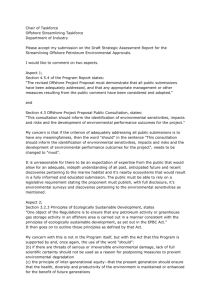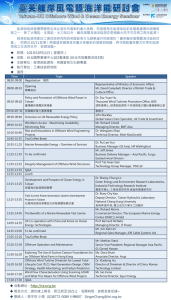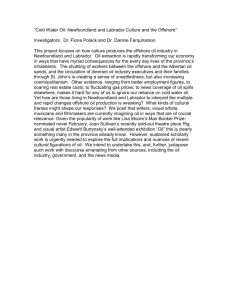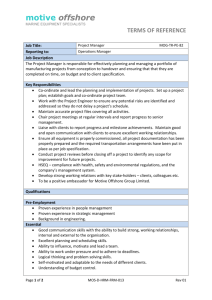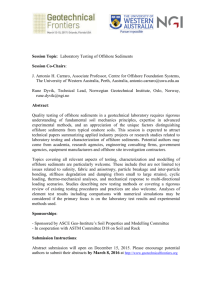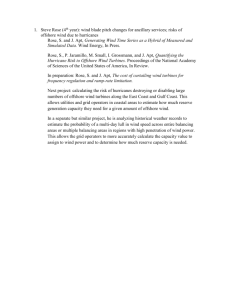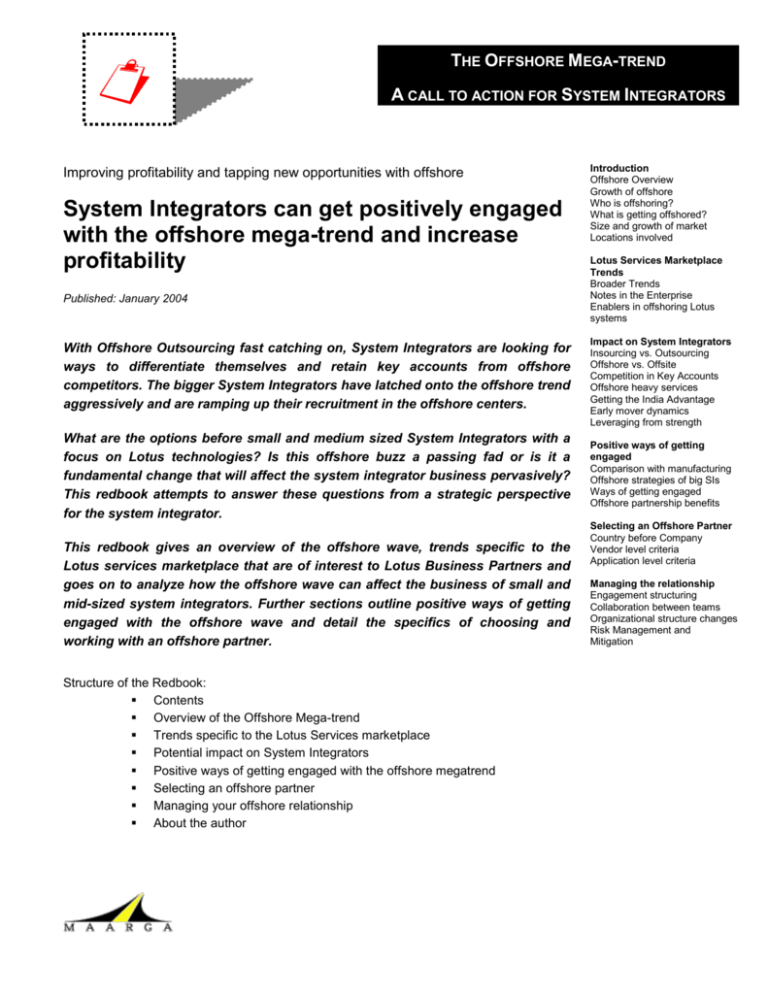
THE OFFSHORE MEGA-TREND
A CALL TO ACTION FOR SYSTEM INTEGRATORS
Improving profitability and tapping new opportunities with offshore
System Integrators can get positively engaged
with the offshore mega-trend and increase
profitability
Published: January 2004
With Offshore Outsourcing fast catching on, System Integrators are looking for
ways to differentiate themselves and retain key accounts from offshore
competitors. The bigger System Integrators have latched onto the offshore trend
aggressively and are ramping up their recruitment in the offshore centers.
What are the options before small and medium sized System Integrators with a
focus on Lotus technologies? Is this offshore buzz a passing fad or is it a
fundamental change that will affect the system integrator business pervasively?
This redbook attempts to answer these questions from a strategic perspective
for the system integrator.
This redbook gives an overview of the offshore wave, trends specific to the
Lotus services marketplace that are of interest to Lotus Business Partners and
goes on to analyze how the offshore wave can affect the business of small and
mid-sized system integrators. Further sections outline positive ways of getting
engaged with the offshore wave and detail the specifics of choosing and
working with an offshore partner.
Structure of the Redbook:
Contents
Overview of the Offshore Mega-trend
Trends specific to the Lotus Services marketplace
Potential impact on System Integrators
Positive ways of getting engaged with the offshore megatrend
Selecting an offshore partner
Managing your offshore relationship
About the author
Introduction
Offshore Overview
Growth of offshore
Who is offshoring?
What is getting offshored?
Size and growth of market
Locations involved
Lotus Services Marketplace
Trends
Broader Trends
Notes in the Enterprise
Enablers in offshoring Lotus
systems
Impact on System Integrators
Insourcing vs. Outsourcing
Offshore vs. Offsite
Competition in Key Accounts
Offshore heavy services
Getting the India Advantage
Early mover dynamics
Leveraging from strength
Positive ways of getting
engaged
Comparison with manufacturing
Offshore strategies of big SIs
Ways of getting engaged
Offshore partnership benefits
Selecting an Offshore Partner
Country before Company
Vendor level criteria
Application level criteria
Managing the relationship
Engagement structuring
Collaboration between teams
Organizational structure changes
Risk Management and
Mitigation
Overview of the Offshore Mega-trend
Offshore outsourcing refers to the practice of sending a service job overseas for execution.
The most common type of offshore outsourcing is that of software application development
and maintenance, whilst other types of outsourcing including inbound/outbound call centers
and claims processing are growing. While manufacturing has been outsourced to globally
competitive locations for over 20 years, the trend of outsourcing services is a relatively new
one and has been growing over the last decade due to the growth of internet, improved
global communications capabilities and supply-demand imbalances in programming talent.
Outsourced services are executed in multiple models including onsite (at the customer
premises), offsite (within the country, but away from the customer premises), nearshore (in
a neighboring country like Canada/Mexico/Carribean) and offshore. More often than not a
single vendor offers a mix of these models to cater to the needs of the customers. The
speed with which offshore is growing has created a “backlash” effect in the US and in
Europe with displaced programmers voicing protest on this phenomenon. Most experts
conclude that while the backlash can slow down the pace of outsourcing or can affect
outsourcing decisions in the government sector, the offshore outsourcing trend is here to
stay.
Growth of Offshore
Offshore outsourcing, which began in a small way in late 1980s, has grown fast to
acquire significant dimensions as an industry. Though consolidated figures are not
easily available, a good way to estimate the growth in the industry is to look at the
growth of software services exports from India, the leader in offshore outsourcing. The
figure below from NASSCOM shows the growth of the Indian offshore outsourcing
services business:
In this section
What is offshore outsourcing?
Growth of offshore
Underlying business drivers
Offshore Enablers
Who is offshoring?
What is getting offshored?
Size and growth of market
Offshore Locations
Voices
"Offshore outsourcing is just
one small part of a (US)$5
trillion global outsourcing
market. This market is growing
by more than 15 percent per
year, and the offshore
component is certainly among
the fastest growing"
- Michael Corbett, Michael F.
Corbett & Associates
Based on a survey of leading
IT services vendors, the
offshore component in the
delivery of U.S. IT services
may rise to as much as 23%
by 2007, up dramatically from
5% in 2003. – IDC
The three leading Indian
companies – Tata
Consultancy Services (TCS),
Infosys and Wipro – continue
to grow impressively. The
largest, TCS grew by 28% in
its last financial year. In the
final quarter of 2002, Infosys
grew 45% and Wipro by 23%.
And this in an IT services
market that is flat in most
developed countries. In fact,
we believe that one of these
players will make it into the
global IT top 10 by the end of
this decade. - Ovum
Another way of getting an idea of the growth of offshore outsourcing is to look at the
anecdotal evidence of the growth as available through trade journals and websites:
Consulting company McKinsey estimates that by 2010, the U.S. IT industry will
save $390 billion through offshore outsourcing of software development.
India's IT sector exported $10 billion worth of goods and services last year, and
projects it will reach $21 billion to $24 billion in 2008.
Forrester Research estimates that in the next 12 years, 3.3 million IT jobs will leave
the United States and go overseas
Gartner reported that by the end of next year, one out of every 10 jobs with U.S.based information technology vendors and service providers will be exported. By
2004, according to the 2002 Gartner report, more than 80 percent of corporate
boards of directors will have considered offshore outsourcing, while 40 percent of
corporations will have finished an outsourcing pilot program or be actively involved
in outsourcing technology services.
Gartner Inc. announced that the offshore outsourcing horse will ride off with one in
20 IT jobs by the end of 2004. The percentage is even more salient in the software
industry. According to research firm Sand Hill Group, more than 80% of software
companies are (or will be by this time next year) offshoring code-writing duties or
implementation work. Sand Hill surveyed executives from 51 software companies
to get its figures.
Underlying Business Drivers:
#
1
Business Driver
Flat Economy
2
Speed, time to market
3
Cost
4
Quality
5
Readily available resources
6
Increased awareness, success
Explanation
The stagnant economy over the last few years and
the overspending on IT in the preceeding boom
years has led to tight control over tech budgets and
an aggressive search for cost-savings in IT services.
A larger and more economic talent pool leads to
reduced cycle time in getting big projects executed
leading to shorter time-to-market. Particularly true for
ISVs who are considering offshore.
The main driver is the differential in costs between
onsite and offshore options. The offshore costs could
be as low as 35% of the onsite costs.
Most offshore vendors are very strong on software
engineering processes and quality improvement.
Indian offshore vendors have more CMM
certifications across levels than the combined
certifications across the western world
Talent rich offshore markets can bring to bear huge
teams with requisite skills for different type of
projects. Even in these days of easy availability of
talent, oftentimes, offshore is a significant option
because of simple lack of availability of requisite
numbers/skills in the domestic talent market.
The media hype around offshore is making
“In the late 1990s, U.S.
companies overspent on
technology by $250 billion,
according to McKinsey Global
Institute. Companies are now
bogged down with operating
these systems. In fact, the cost of
managing the IT infrastructure
built during the boom consumes
70 percent to 80 percent of the IT
budget in large enterprises. About
half of that figure represents labor
costs.” – George Gilbert/Rahul
Sood (ZDNet)
stories
7
3-shift work day
8
Freeing up resources for more
critical work
companies, CFOs look for options and this leads to
the discovery of other drivers that make offshore
attractive.
For a lot of the back office work around sustaining
systems, there is a need for round the clock work,
and offshoring to certain time zones is an
advantageous option.
Deploying crucial internal staffers on more strategic
projects is a driving factor for some enterprises
Enablers of offshore outsourcing:
While we saw the business drivers that are making customers seek out offshore
outsourcing options, the global infrastructure to enable large-scale offshoring has fallen in
place only in the recent years. Here is a look at few of them:
Global telecom/datacom growth – The late 90s saw orders of magnitude increase
in telecom and datacom growth across all regions of the world, driven by the dot
com boom, the widespread adoption of IP based networks etc. This growth has
resulted in substantial telecom capacity across the world by way of submarine fiber
optic cables, communications satellites etc. and enables seamless connectivity
between multiple locations that need to collaborate.
Demographics, Availability of talent in the offshore destinations – The last few
decades has seen considerable investment by many countries in their education
infrastructure which has resulted in highly qualified and young people becoming
available for the labor market. Countries like India and China today produce
substantial number of engineering and computer science graduates who are
trained on the latest technology and have the right aptitude for programming work.
Demographically, these locations have a booming younger generation that is
exposed to the global culture and latest technology – something that the mature
western markets can put to good use.
Leaps in quality improvement made by offshore vendors – Software development
as an engineering discipline has grown over the last decade resulting in
comprehensive models to evaluate and improve the software processes of delivery
organizations. Offshore vendors have been quick to adopt these models and have
made huge improvements in the process by which software gets produced. This
enables outsourcing software projects to remote locations, which cannot otherwise
be successful given their complex nature.
Who is offshoring, what gets offshored
Offshore outsourcing has gained critical mass in the last few years and is seeing
accelerated adoption by many segments of customers. Offshore sourcing happens in
two broad types of organizational structures:
Captive units – Organizations set up a development or a subsidiary that is either
fully or partially owned by them
Outsourcing – Organizations working with third party vendors to fulfill specific
needs
Most of the big enterprises follow the latter route. Among America's biggest companies,
those using offshore programming include American Express, Aetna U.S. Healthcare,
Compaq, General Motors, Home Depot, Microsoft, Motorola, Shell, Sprint, and 3M. A
lot of the bigger systems integrators have started developing a captive base in the
offshore centers including IBM Global Services, Cap Gemini Ernst & Young, Accenture
Sapient and Xansa.
A broad range of services is rendered from these offshore facilities. This graph from
NASSCOM shows the kind of work that happens offshore in India. Though slightly
dated, this data is representative of the kind of work that gets offshored to India and to
other locations.
Size and growth of market:
The global IT services market was estimated by IDC/McKinsey to be around USD 320
billion in the year 2000 and of this the market share of India – the leading offshore
outsourcing player, was around USD 4.75 billion amounting to roughly 1.5% of the global
market. The services market is expected to increase to around USD 600 – 730 billion by
the year 2008. Offshore is expected to grow faster than the other segments of the market,
with India aspiring to have around 4.1% - 4.7% of the market by 2008. These estimates
clearly show that while the services segment itself is growing at a fast pace, the offshore
business is growing faster. The growth does not represent a threat to all the existing
players, though a realignment of strategies might be needed for IT services providers to be
on top of their accounts.
Offshore Locations
India is the leader with a nearly USD 10 billion industry, 260 of Fortune 1000 outsourcing to
India, the highest number of CMM-certified companies in the world, 900 export only
companies employing 415,000 professionals and a total labor force of 439 million to its
credit.
Other offshore destinations include China, Philippines, Ireland, Russia and Canada.
“With the early-mover advantage,
India remains the offshore
country of choice: a large, lowcost, English-speaking talent pool
and the most mature market in
the world” – CIO magazine
Offshore and the Lotus Notes services marketplace
In line with the focus of this redbook on system integrators focused on the Lotus Notes
services space, this section deals with the broad changes taking place in the Lotus Notes
services marketplace and talks about how offshoring could play out in this space.
Trends in the Lotus Services marketplace
Move towards J2EE – In the big war for the enterprise application platform space,
IBM seems to be throwing its weight behind Websphere. Though IBM has clearly
and consistently maintained that the Lotus Domino server will go through at least
two more versions, the momentum building around J2EE is a matter of significance
for system integrators specialized on Lotus technologies. When Websphere gets
all the functionality that differentiate the existing Domino platform, further
development is likely to be on the J2EE platform for newer applications. The huge
user base of Domino is likely to keep the platform alive for existing production
applications for a long time, though system integrators would like to pick up skills
and play in the J2EE space when things start changing with their customers.
Integration with other enterprise applications – The big story of the day is
integration and making applications do more by working together. A lot of
enterprises have slowed down on totally new applications after the binge of late
90s and are going in for extracting more value from their existing assets. A key
component of this trend is the web services strategy of enterprises and platform
vendors. We are likely to see a lot of Lotus applications being enhanced to live in a
service-oriented architecture.
Increase of web based applications – An old story by now, the thin client is likely to
play an increasing role in newer applications. Lotus has done an excellent
balancing act with its iNotes client, which offers many advantages of the thin client,
while still retaining what is good about thick clients. With further standardization in
the core presentation and transport technologies, the thin client is likely to increase
its share in the presentation layer. Existing Domino applications work well with
browsers, but might need enhancements to take advantage of the thin client
paradigm. This would imply new service opportunities for Lotus focused system
integrators.
Workplace offerings – The new Workplace suite of offerings is an attempt by IBM
to leverage the strengths of Domino and penetrate more markets by focus on
compliance with contemporary standards and verticalize the service offerings. This
is a spin off of the movement towards J2EE trend and is likely to result in different
types of services opportunities.
Consolidation of early gains in Instant Messaging, Team Collaboration – Lotus has
an early mover advantage in the enterprise Instant Messaging space, and this
In this section
Trends In the Lotus services
marketplace
Notes In the Enterprise
Offshoring Lotus Notes
services
Voices
"Many U.S.-based Domino
professionals are competing
for jobs with workers that
they'll never run into at a user
group meeting or technology
conference.”
– SearchDomino.com
technology is moving to the mature adoption phase. This would result in additional
services around integrating presence technology in existing infrastructures.
All these trends would have implications to Lotus business partners on the kind of services
projects that would come their way in the future. These trends also involve making choices
about skill upgrades and transitions. System Integrators need to evaluate the offshore
mega-trend in tandem with these trends that are specific to the Lotus space while evolving
a delivery strategy.
Notes in the Enterprise
While a lot of organizations are standardized on Lotus Notes/Domino as the messaging
platform, there are a smaller number of organizations that are standardized on Lotus
Notes/Domino as the application server platform. Big enterprises have a numerous types of
backend systems in place to support the mission-critical database and transaction-based
applications that drive their businesses. While outsourcing their IT requirements, such big
enterprises consider Lotus Notes only a part of a bigger puzzle and seek to establish
relationships with vendors who provide them with skills across all their technology
platforms. Enterprises also prefer outsourcing relationships where a vendor brings in a
deep understanding of the business domain of the enterprise and not just technology
expertise.
“Offshorability” of Lotus Notes Services: Not all IT projects are ideal
candidates for offshoring. The graph in this section, derived from a McKinsey framework,
outlines the considerations that make a project a candidate for offshore and explores which
typical Notes services are “offshorable”. A lot of Lotus Notes projects have historically been
executed as quick turnaround projects with little formal design. But over time, corporations
have accumulated a sizable inventory of Lotus Notes based applications. Lotus Notes
projects requiring quick turnaround are good candidates for offshoring only if there is an
established relationship between the onsite/customer-facing team and the offshore team.
Some good candidates for Lotus Notes offshoring include:
Maintaining a big inventory of Lotus Notes applications
Redesign of a bulk of applications to standardize design and establish common UI
standards.
Moving Lotus Notes application to newer frameworks like J2EE etc.
The core architecture of Lotus Notes and the new associated products like Sametime,
QuickPlace enable remote teams to work together naturally. The robust replication
functionality of Lotus Notes helps in managing the complexities associated with setting up
an offshore infrastructure.
Some of the big customers in the US who outsource their Lotus Notes work offshore
include MetLife, PriceWaterhouseCoopers, IBM, Ernst & Young, American Express,
America West Airlines and Symantec.
Potential impact of offshoring on System Integrators
Potential impact on System Integrators
Insourcing vs. Outsourcing
Offshore as a % of Outsourcing
Competition in Key Accounts
Scope of services offered by SI vs. Offshore enabled company
Using India to SI advantage
Early movers vs. Late movers
Leveraging from strength – the services that are better done onshore
Insourcing vs. Outsourcing:
The offshore trend is a combination of the outsourcing trend and globalization. Enterprises
are increasingly getting their software development & maintenance done through external
service providers. In-house software teams are difficult to retain, keep motivated and
measured accurately on productivity. System Integrators as a whole have benefited from
the trend towards outsourcing. They find it easier than enterprises to recruit and retain
talent and given their specialization, System Integrators do a better job of delivering the
information systems projects on time and within budget.
But the offshoring trend is seen mostly as a threat by system integrators. Given the trend
towards globalization enterprises are seeking out the best resources available from any
part of the world. Rapid progress made in communication infrastructure around the world in
the late 1990s have contributed to making offshore work a reality for the mainstream IS
shop today. Offshore development as a percentage of total outsourcing is steadily
increasing. For example, the Indian IT and back office services industry is expected to
export services to the tune of USD 77 billion in 2008 up from USD 3.1 billion in 1998.
System Integrators are facing competition in their key accounts. These big accounts which
spend millions of dollars annually on their Information Systems are looking at driving down
the costs of routine tasks by utilizing offshore resources. Though Lotus Business Partners
are better placed given their niche specialization, the threat is tangible given that the
offshore vendors strike a broad based relationship with the customer.
System Integrators provide a multitude of services to their client base including:
Integration of hardware and software
Customer needs analysis
Hardware maintenance/upgrades on equipment your company sold/recommended
Strategic technical consulting
LAN/WAN design/configuration
Training
In this section
Insourcing vs. Outsourcing
Getting the India Advantage
Early Mover Advantage
Leverage from Strength
Voices
“IT services companies unable
to develop their own offshore
capabilities must seek
partnerships to keep pace with
the offshore wave. Mid-sized
and smaller players lack the
cost and flexibility benefits of
the offshore model in their
business and therefore risk
becoming less and less
competitive, or less and less
profitable. Partnerships will
enable them to survive.” Ovum Holway (analyst and
consulting company).
Network administration/management
Remote support
Product comparisons/specification
Software support (e.g., customization of proprietary software)
Application development: custom solution development
Strategic business consulting
Outsourcing of customer IT functions
Remote management
Website development - creative/page design/user interface
Web integration/Internet services
Web site development – backend
Application development: development of application for general resale
Integration of voice and data networks
Web hosting
Outsourcing of customer business functions
ASP Services
Not all of these are equally susceptible to competition from offshore vendors. System
Integrators need to differentiate themselves by offering services that are not easily
offshored and where there is a tangible value add to the customer.
Getting the India Advantage.
The big Systems Integrators in the US market have jumped onto the offshore
bandwagon driven primarily by their customers who demand offshore/blended pricing.
EDS, Accenture, Bearing Point, IBM Global Services are all present in the key offshore
talent markets enabling them to stay competitive in their respective markets. The
smaller system integrators also need to tap into the offshore talent pool to stay
competitive. Given that setting up an offshore operation involves considerable time and
financial commitment, the best route for the smaller players is to establish partnerships
with smaller offshore players. System Integrators need to analyze their portfolio of
service offerings and strengthen those offerings that require an onsite presence and
are heavy on customer interaction while sourcing services from their offshore partners
for the other services.
Such a partnership can result in a host of benefits to the small system integrator
including:
Increased profitability on the work executed offshore
Deeper penetration into existing customer accounts by offering services that
were hitherto unviable from a commercial/staffing perspective
Fending off competition from the bigger offshore players who nibble into key
accounts by offering offshore options.
A financially sustainable variable cost structure that prevents erosion of
profitability during lean periods
Ability to ramp up substantially to staff big sized projects at a short notice.
Early Mover Advantage:
Early movers among system integrators to offer offshore services are likely to get the
advantages of a developing market, just as in any other service offering. System
Integrators who develop deep relationships with an offshore partner and learn how to blend
the offshore story into their own service offering are likely to stay on top of this wave and
realize substantial gains at the expense of those who do not latch onto the trend fast
enough. Fewer competitors and a message well received by customers will result in
considerable gain in market share for those system integrators who mix their service
offerings with appropriate offshore services.
Leveraging from Strength – services better done onshore
The media hype has blurred the role of offshore services in the IT services marketplace.
Offshore outsourcing, though a megatrend, is a part of the overall dynamics of the
marketplace and needs to co-exist with onsite outsourcing to deliver value to customers.
Onsite services will continue to thrive as enterprises extend their IT infrastructures to
embrace e-business.
Positive ways of getting engaged with the offshore trend
The manufacturing industry example
How the biggies are doing it
Ways of getting engaged
Benefits of getting wired for offshore
Contrast with manufacturing
Though the offshoring trend is often compared to the way manufacturing moved to China,
there are significant differences between the two trends. For one, the discipline of
conceiving and developing software applications is an emerging one and does not lend
itself to being moved lock, stock and barrel. Even when significant pieces of software
development are offshored, big parts of the process still remain firmly onshore – including
business/IT consulting, drawing up specifications and acceptance testing. But the model
might be replicated at a more basic level where bulk of the customer relationship/interface
is done onsite and any production type tasks are done offshore. Though the concept of
software factories has never taken off, it offers a good starting point for SIs to get engaged
with the offshore trend. SIs can look at their transitioning their organizations into a
consulting/project management organization. They can use their offshore organization (or
their partner’s organization) as a technology backend and manage all the project
interaction with the client.
How the biggies are doing it
All the big System Integrators – including IBM Global Services, Accenture, Bearing Point,
Cap Gemini E&Y and EDS have offshore as a big part of their plans. Accenture outlines
the key reasons why to consider offshore:
Economic Prize – The economics of going offshore makes outsourcing pretty
attractive. By leveraging an existing operation or an outsourcing provider,
organizations get access to greater variability in operating costs combined with the
ability to cover peaks in demand.
Capability - In the better service providers the qualifications, experience and
capabilities of the staff is at a level well beyond initial expectations and well above
the standard that can be easily recruited onshore.
Human Impact - The move offshore can often provide the opportunity to implement
a new business model that breaks with the problematic legacies of the past,
particularly in terms of IT and working practices.
In this section
Contrast with manufacturing
How the biggies are offshoring
Ways of getting engaged
Benefits of getting offshore ready
Voices
“Much of the offshore spending
will be captured by locally-based
vendors, who are currently
building up their own offshore
delivery resources” – IDC
Market Impact – The pressure on organizations to deliver substantial value
enhancements by reworking eCommerce, CRM and sourcing strategies leads
companies to consider offshore
All the big System Integrators are committing big on a global sourcing/development model
to cater to varied needs of their customers. The bigger ones like IBM Global Services &
Accenture are expected to have over 10,000 employees in their India development centers
in the next couple of years.
Ways of getting engaged:
Use offshore to drive down fixed costs and move to a variable cost structure
Offer additional services like maintenance to the existing client base by leveraging
the organizational capabilities of your offshore partner
Start with a project-based outsourcing and move onto a small retainer team to
preserve business knowledge and to lay the path for long-term value
enhancements.
Invest in an offshore partner or explore cross holding
Explore business process outsourcing opportunities available around traditional IT
services to enhance revenue/profits per client.
Benefits of getting offshore ready:
The offshore outsourcing trend has been characterized as an “irreversible megatrend’ by
Gartner. Similar predictions have been made by most other industry analysts, consulting
organizations on the size, scale and momentum of this new way of working. Offshore
outsourcing fits with the basic theme of globalization and is expected to drive benefits to
both the vendor and customer countries by way of increased value add. In fact, a McKinsey
report says “Of the full $1.45 to $1.47 of value created globally from offshoring $1 of the US
labor cost, the US captures $1.12 to $1.14 while the receiving country captures, on
average, just 33 cents”. System Integrators who recognize this trend and get ready to latch
onto it stand to gain a lot including:
Early mover advantage in a rapidly realigning market
Increased retention of key customers who are considering offshore options
Increased profitability aided by lower costs and a variable cost structure
A focus on sustainable core competencies laying the foundation for strong future
growth.
Selecting an Offshore Partner
Country before Company
Though it might look counter-intuitive, given the wide variety of choices available in going
offshore, System Integrators would do well to choose the country they are going to have an
offshore relationship with before choosing a specific company. A lot of advantages enjoyed
by offshore vendors are primarily derived out of the talent pool, networks and diasporas
which are country specific factors and not company specific. A detailed comparison of all
available choices is presented at http://www.cio.com/offshoremap. A brief analysis shows
that India is the most favored offshore destination for most people. The labor cost
advantage, depth of technology talent, maturity of software processes, English language
skills, industry maturity and government support the Indian IT industry provides is by far the
best in the entire world. Here are a couple of quotes from reputed industry experts on
India’s advantage:
“With the early-mover advantage, India remains the offshore country of choice: a large,
low-cost, English-speaking talent pool and the most mature market in the world.” – CIO
magazine
“While there is much talk of China, Russia and several other offshore destinations, Ovum
Holway does not anticipate any country producing a group of indigenous offshore
companies to rival that of India before the end of this decade.” – Ovum Holway
Vendor level criteria:
For a system integrator, the following factors are critical in appraising vendors to partner
with:
Experience in the chosen domain, technology
US/International exposure of the team
Flexibility of engagement models
Appraisal of client integrity related issues
Process maturity
Flexibility of pricing models
In this section
Country before company
Vendor level criteria
Managing your offshore relationship
System Integrators should approach their offshore partnership from a strategic perspective
and should plan on spending considerable time and resources to make the effort a
success. The benefits of offshore outsource are huge, but can be realized only by thorough
planning and consistent execution.
The System Integrator needs to prepare an offshore roadmap in consultation with the
offshore vendor. A program management office is a good idea for bigger system
integrators. The offshore roadmap should outline the communication plan, identify an
internal champion for making the offshore partnership a success, and should outline a
master agreement that defines service levels, rates and volume discounts.
Engagement Structuring:
Offshore relationships could span an entire spectrum of contractual formats as outlined in
this graph from McKinsey analysis:
The System Integrator should hone in on the ideal contract relationship and should put a
master agreement in place with the offshore vendor. The contract should be a formalized
statement on the responsibilities of each party, the objectives for the relationship and ways
in which performance will be measured and compensated. For small system integrators a
long-term master contract or a small retained team would be an ideal fit, while bigger
system integrators might want to consider an Offshore Development Center – a dedicated
facility staffed and managed by the offshore vendor with an optional BOT (Build Operate
Transfer) clause.
In this section
Engagement Structuring
Collaboration between distant
teams
Organizational Changes
Risk Management, Mitigation
Collaboration between distant teams:
Telecom Infrastructure
Product Architecture
Collaborative
technology
Team
Building
Development
Methodology
Managerial techniques
Source: Global Software Teams, Erran Carmel
System Integrators should adopt the best practices in remote team development. The
following is a list of key enablers that should be addressed for remote collaboration:
Telecom Infrastructure
Reliable, high bandwidth connections to all desktops at all sites
Infrastructure for VPN access to SI/Client’s network if necessary.
Collaborative Technology
Synchronous
Different
Video conference
Audio conference
E-chat
E-whiteboard
Place
Same
Time
Asynchronous
E-mail
Voice mail
Project Extranet
Groupware
Discussion lists
Meeting-ware
These collaborative tools:
Serve as team memory and knowledge center
Provide each team member a 360degree view
Foster a sense of community and create a shared context
Development Methodology
As opposed to smaller, co-located teams that use informal mechanisms for development,
dispersion often leads to greater formalism of coordination and control, viz.:
Specific standards
Specific methodologies
Specific quality control issues
The offshore vendor needs to adopt a development methodology that is inspired by the
best ideas from:
Rational Unified Process
The Capability Maturity Model framework for software process improvement
Xtreme Programming
This methodology acts as a map that guides the team through the Software Development
Life Cycle (SDLC)
Product Architecture
A modular, componentized architecture using standard application frameworks like J2EE
helps in allocating tasks and minimizing co-ordination costs. In the case of Quality
Assurance, the work is well developed and product architecture does not play a critical role
in ensuring the success of the global team.
Team Building
For the teams to be successful, there needs to be constant interaction between the SI’s
project manager and the offshore team. Any forms of personal bridges between the two
sites including travel and expatriates help in team cohesion. An onsite coordinator plays a
key role in this team building process.
Managerial Techniques
The project manager needs to keep up with the latest techniques in project management
and will make a definite impact on the success of the effort. The offshore project managers
should use effective methods of project management like:
o Creating statement of work
o Estimating task times and costs
o Work breakdown schedule
o Task timelines
o Creating project budget
o
Conducting risk management
Structural Changes in delivery organization
The System Integrator should examine its organizational structure and be ready to make
necessary changes to incorporate offshore services into its DNA. An effective delivery
organization at the System Integrator would have an internal champion who would be
sensitive to cultural differences between the local and offshore teams and would have a
mandate to make the offshoring strategy deliver results. The internal champion should also
be responsible for monitoring the service levels from the offshore vendor and should be
empowered to make the contract work.
Risk Management and Mitigation
Risk
Cultural Differences. Indians are different
from Americans in many ways. There are
many cultural differences including a
tendency among Indians to avoid
confrontation, hesitation to ask for help etc.
Time zone differences.
Knowledge Retention
Turnover within the offshore team
Mitigation Strategies
The onsite coordinator and offshore project
managers have aggressive performance
criteria and should be groomed to spot
these cultural differences. The staffers of
the System Integrator should visit the
offshore facility and the offshore team
members should visit the onsite facilities on
a rotating basis to help clear up cultural
differences.
The offshore organization should typically
have a good overlap with the System
Integrator’s working hours. Besides the
extranet and Instant Messenger are good
tools to keep everyone on the same page.
During the Knowledge Acquisition phase,
the offshore team should work on capturing
the knowledge in external sources like
documents. These should form the basis for
a training course for new inductees into the
offshore team.
Though this is much less of a problem in
today’s conditions, an economic revival will
increase the incidence of this risk. The
offshore vendor should address this by
loading the team with additional resources
upfront to provide for some redundancy.
The offshore project managers should
provide a consistent interface to the SI’s
managers.
For More Information
This redbook has been brought to you by Maarga Information Systems (P) Ltd., an IBM Partner based in Chennai,
India with a focus on Lotus technologies. For more information about Maarga’s services, call Maarga Systems at
(773) 913-9841. In India, call the Maarga information Centre at +91-44-3102-4338. To access information via the
World Wide Web, go to: http://www.maargasystems.com/
© 2004 Maarga Information Systems (P) Ltd. All rights reserved.
This case study is for informational purposes only. MAARGA MAKES NO WARRANTIES, EXPRESS OR
IMPLIED, IN THIS SUMMARY. Lotus Notes, Domino, Quickplace, Sametime are either registered trademarks or
trademarks of IBM Corporation in the United States and/or other countries. The names of actual companies and
products mentioned herein may be the trademarks of their respective owners.


